Velvet is a popular fabric that is used for several purposes.
Available in many colors and thicknesses, velvet looks great on blankets, dresses, and even hats.So, how is this beautiful and luxurious fabric made in the first place? Keep reading to find the answer in this article.
We’ll also cover the several types of velvet currently available on the market.
What Is Velvet?
Velvet is a fabric that is smooth and soft to the touch.
As it has a plush finish, velvet is used for lingerie, furnishings, and home textiles.
It used to be expensive to produce, so only rich families could afford it in the past. This is why people often associate velvet with royalty. Today, velvet is made with less expensive artificial materials.
Despite being more affordable now, velvet is one of the sleekest and most luxurious materials known to man.
How Is Velvet Made?
Velvet can be made out of many materials, but the process is the same no matter what substance is used.
It’s made in vertical yarns on a particular type of loom. This loom weaves two sheets of material of different thicknesses on top of each other.
These layers are then separated, giving velvet its sheared appearance. The fabric is then wrapped around two individual rolls.Both velvet and velveteen are made with the same process.
However, velvet is made with vertical yarn, and velveteen is made with horizontal yarn.
Velveteen can also be mixed with standard cotton, but this makes it lower quality as it changes the texture.Different materials are used to make velvet. Silk is a popular example.
Silk threads are taken from silkworm cocoons, then spun into yarn.
Velvet can also be made from synthetic materials, like rayon. Once the yarn is made into velvet, it can be dyed in different colors or chemically treated for various uses.
How Is Velvet Used?
Velvet’s main advantage is that it is soft, so it’s employed in uses that involve placing fabric next to the skin. Velvet is also visually pleasing, so it’s used for home textiles, like cushion covers, bedding, and blankets.
Velvet is superior to other fabrics in that it feels and looks good, so it remains a popular decor fabric choice.
Velvet is used in clothing, though it is seen more in womenswear than men’s clothing. However, velvet is used to make higher quality menswear, like smoking jackets, robes, and tuxes.
Many women like velvet as it flatters curves and picks up a subtle pleasing sheen.
Velvet is also a popular fabric choice for accessories. Stiffer varieties can be made into hats, while softer ones can line gloves and scarves.
Where Is Velvet Made?
A large number of textiles come from China, and velvet is no exception.
China creates most of the world’s velvet supply, but many silk-based velvet rolls are also made in India.China may make most of the world’s silk, but India follows close behind.
Indian silk is generally better in quality and has a higher chance of being certified.
China also makes the largest share of synthetic fabrics, which includes rayon.
Velvet made from rayon is generally more affordable than silk-based velvet. However, without regulations, China is responsible for a large proportion of the world’s pollution. Many countries are slowly changing to sustainable fabric production methods, but China still has to make the switch.
Cost Of Velvet
As stated previously, synthetic-based velvet is lower quality and cheaper. In contrast, velvet made entirely from silk is very expensive. As a lot of work goes into creating this fabric, silk-based velvet can cost hundreds of dollars per yard.
Similarly, velvet made from sustainable fabrics and eco-friendly methods will cost more than cheaply produced fabrics.
Different Types Of Velvet

People normally know that velvet has a plush feel and texture, but there are many different types of velvet on the market. These include:
Crushed Velvet
This is one of the most popular forms of velvet. Instead of a flat texture, crushed velvet has a mixed finish that is pleasing to the eye.
This texture is made by manipulating the fabric while it is wet. Pressing, twisting, and rolling wet velvet makes it rise in different levels, giving it its random, but beautiful feel.
Chiffon Velvet
Chiffon velvet is very sheer, which is why it’s also known as transparent velvet. It’s mainly used in evening clothing and formal wear.
Ring Velvet
Previously, this type of velvet could only be labeled as ‘ring’ if it was threaded through a wedding ring. Ring velvet is like chiffon, as it is fine, light, and sheer.
Embossed Velvet
Embossed velvet is personalized, as it can have words, shapes, and symbols embossed into the fabric.
The embossed area is shorter than the rest of the velvet to make these features stand out, but it is still soft and smooth to touch.
Voided Velvet
Just like embossed velvet, voided velvet can have patterns, shapes, and symbols on its surface. These features are made from areas either with or without piles.
Hammered Velvet
This is one of the most luxurious types of velvet. Instead of being crushed, the fabric is pressed with a lot of force. The surface looks speckled with different shades which pick up nicely under natural light.
Panne Velvet
Panne velvet started as a crushed velvet that was manipulated through one singular movement.
The meaning has changed over the years. Panne now refers to velvet with a clustered look and finish.
Lyons Velvet
Lyons velvet is thicker and stiffer than other types, which is why it’s used for accessories and outerwear.
This type of velvet is normally found on coats and hats. It is also known as one of the most affluent materials known to man.
Utrecht Velvet
This type of velvet is strong and thick, but it isn’t used as much today. However, it is occasionally used to make dresses and formal wear, as it has a nice crimped appearance.
Environmental Impact Of Velvet
Velvet isn’t a type of material, but a method of weaving fabric. This means that it is incorrect to say that velvet has any environmental impact. However, velvet is made out of different materials which can affect the environment in several ways.
Effect Of Silk On The Environment
From an environmental point of view, silk is considered a sustainable fabric. Generally speaking, silk production hasn’t changed for centuries.
Silk is biodegradable and there are no pesticides, fertilizers, or harmful chemicals needed to make it.
However, as silk is made from silkworms, there are concerns over the treatment of animals from animal rights groups. This means that silk has a mixed environmental impact.
Effect Of Rayon/Synthetics On The Environment
During velvet production, rayon is often used as a silk alternative. Creating rayon and other synthetic materials can have harmful environmental effects.
Producing rayon requires petroleum for many chemical washes. It also releases many toxic chemicals into the environment while it’s being produced. Rayon is only made today because it is very cheap to make.






